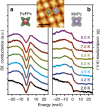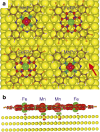Long-range ferrimagnetic order in a two-dimensional supramolecular Kondo lattice
- PMID: 28530247
- PMCID: PMC5458152
- DOI: 10.1038/ncomms15388
Long-range ferrimagnetic order in a two-dimensional supramolecular Kondo lattice
Abstract
Realization of long-range magnetic order in surface-supported two-dimensional systems has been challenging, mainly due to the competition between fundamental magnetic interactions as the short-range Kondo effect and spin-stabilizing magnetic exchange interactions. Spin-bearing molecules on conducting substrates represent a rich platform to investigate the interplay of these fundamental magnetic interactions. Here we demonstrate the direct observation of long-range ferrimagnetic order emerging in a two-dimensional supramolecular Kondo lattice. The lattice consists of paramagnetic hexadeca-fluorinated iron phthalocyanine (FeFPc) and manganese phthalocyanine (MnPc) molecules co-assembled into a checkerboard pattern on single-crystalline Au(111) substrates. Remarkably, the remanent magnetic moments are oriented in the out-of-plane direction with significant contribution from orbital moments. First-principles calculations reveal that the FeFPc-MnPc antiferromagnetic nearest-neighbour coupling is mediated by the Ruderman-Kittel-Kasuya-Yosida exchange interaction via the Au substrate electronic states. Our findings suggest the use of molecular frameworks to engineer novel low-dimensional magnetically ordered materials and their application in molecular quantum devices.
Conflict of interest statement
The authors declare no competing financial interests.
Figures




References
-
- Mermin N. D. & Wagner H. Absence of ferromagnetism or antiferromagnetism in one- or two-dimensional isotropic Heisenberg models. Phys. Rev. Lett. 17, 1133–1136 (1966).
-
- Hewson A. C. The Kondo Problem to Heavy Fermions Cambridge Univ. Press (1993).
-
- Bogani L. & Wernsdorfer W. Molecular spintronics using single-molecule magnets. Nat. Mater. 7, 179–186 (2008). - PubMed
-
- Hanson R., Kouwenhoven L. P., Petta J. R., Tarucha S. & Vandersypen L. M. K. Spins in few-electron quantum dots. Rev. Mod. Phys. 79, 1217–1265 (2007).
-
- Gambardella P. et al.. Ferromagnetism in one-dimensional monatomic metal chains. Nature 416, 301–304 (2002). - PubMed
Publication types
LinkOut - more resources
Full Text Sources
Other Literature Sources

